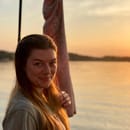For those of you who know Regan you know that she is one driven woman. I am lucky enough to know her because she is my roommate. Originally from Apple Valley, MN, Regan Holm is currently a junior studying Cardiac Rehab here at Winona State. She enjoys doing activities like playing volleyball, being crafty, and socializing.
Her Campus (HC): Hello! Before we begin, what three words would you say describe you?
Regan Holm (RH): Fiery, determined, and loyal.
HC: You’re part Native American; what tribe are you from?
RH: The White Earth band of Ojibwe and Red Lake.
HC: Was there anything that inspired you to learn more about your heritage?
RH: I find my identity in having knowledge of my heritage, and I find it amazing that each nation is very different from the next and have their own systems that are unique to it. I also feel that because I am educated on Native American affairs I feel pride in breaking the construct that most of America expects me to look like: tanned skin, hair down to my waist, dark eyes.
HC: How have you become more involved with your heritage?
RH: By being vice president of a Native American club on campus (TISO: Turtle Island Student Organization) and by involving myself in matters that have to do with indigenous peoples on Winona State’s campus.
HC: How did you become involved with the End of the Trail statue?
RH: I was introduced to Aaron Camacho (another Native American student) my freshman year, which was three years ago, and I sort of took over her initiative to recontextualize the End of the Trail, which is still in the process of being done properly. The following year is when we decided to form TISO as a way to advertise our work on campus.
HC: Can you explain what the project is exactly?
RH: The End of the Trail statue was donated by a late professor, Dr. Irving Bublitz, with the main idea being to strike up conversation. But it’s causing more of a problem actually, and while it may have been appropriate at the time it was donated, now it’s time to recontextualize it so that we can address the serious issue of miseducation or lack of education WSU had about it. It has now been composed as an Indigenous Learning Garden, which will have the End of the Trail statue as well as major components that will pay tribute to the Dakota and Lakota people because this is stolen land from them. This project is over 15 years in the making, and Aaron and I with the help of supporters have been able to get it as far as it has ever come. The new challenge is making sure the administration upholds their promises and that the garden remains in its current place. We’ve had people tell us to move the garden but that would defeat the whole purpose of this project.
HC: Tell us about this year’s Indigenous People’s Day celebration.
RH: I think that it was a great first Indigenous People’s Day! There were definitely some kinks that needed to be worked out, but WSU plans to use this day as a recruitment/celebration day for Native American students across Minnesota. We tried to stress that Indigenous People’s Day was not just for Native Americans, but for all cultures that are indigenous to somewhere. The ceremony was fun, and I really enjoyed the many different cultural dances from the Prairie Island dancers and the tree planting ceremony that took place at the End of the Trail statue.
HC: Since this is a big thing in the news, what are your thoughts about the protest happening at Standing Rock?
RH: I’m happy that it’s starting to get more recognition and media time. This is the first time since 1876 that all the prairie lands of the Lakota, Northern Cheyanne and Arapaho have stood together for one cause. The last time was the battle of Little Big Horn. You might have seen people “checking in” on Facebook at Standing Rock camps, and that’s because the people who are actually there are having their phones jammed so that they don’t have a means of communication. This movement is to basically help confuse those who are jamming the phones. My last thought on this is about people who try and argue the topic when they are completely ignorant about it. For instance, the argument “THE FACTS ARE that the reservation is miles away from the pipeline, and it’s not on sacred ground!” and my response to that is even if that were the case, these ignorant people seem to have missed the point that the pipeline will run through the Mississippi River. So when the pipeline bursts, not only will Standing Rock’s water supply be undrinkable and unusable, but any other city or state that borders the river will be affected by that as well.
HC: Lastly, is there anything else that you’re involved in on campus?
RH: Most recently I was involved with a tour of the native art on WSU’s campus with a very intelligent woman who will be working alongside the art curator at WSU to better display its art in a respected manner. I also work for the inclusion and diversity office, which helps bring speakers to campus and is a liaison for the cultural clubs on campus as well.
Check out Regan Holm and Winona State’s TISO to learn more about the End of the Trail statue and Native American affairs.

